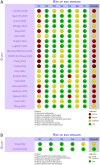Prone positioning during veno-venous extracorporeal membrane oxygenation: a systematic review and meta-analysis
- PMID: 40298974
- PMCID: PMC12129859
- DOI: 10.1007/s00134-025-07877-2
Prone positioning during veno-venous extracorporeal membrane oxygenation: a systematic review and meta-analysis
Abstract
Purpose: The evidence supporting the benefit on clinical outcomes of prone positioning during veno-venous extracorporeal membrane oxygenation (V-V ECMO) for acute hypoxemic respiratory failure remains inconclusive. We aimed to assess the association of prone positioning, compared to no prone positioning, with 28-day mortality and other clinical outcomes in different patient subgroups.
Methods: A systematic review and meta-analysis of randomized and non-randomized controlled trials (RCTs) using a random-effects model was conducted. An electronic database search up to September 1st, 2024 was performed (PROSPERO CRD42024517602). The RoB 2 and ROBINS-I tools were used for risk of bias assessments.
Results: We analyzed two RCTs and 20 non-RCTs (3,465 patients). Compared to no prone positioning, the use of prone positioning was associated with lower 28-day (odds ratio [OR] 0.64, 95% confidence interval [CI] 0.42-0.98, p = 0.040, I2 = 66%, low certainty of evidence [CoE]) and hospital mortality (OR 0.67, 95% CI 0.54-0.83, p < 0.001, I2 = 39%, low CoE), despite fewer 28-day ventilator-free days and longer ECMO duration. Younger age (p = 0.005), a higher sequential organ failure assessment (SOFA) score (p = 0.022), non-Covid-19 etiology (p = 0.003), and lower rates of prone positioning before cannulation (p = 0.049) were associated with a greater benefit from prone positioning.
Conclusion: In this analysis, among patients supported with V-V ECMO for acute hypoxemic respiratory failure, we observed improved 28-day and hospital mortality in those who received prone positioning, compared to those who did not. However, these findings do not imply causation. Further research is needed to clarify the role of prone positioning in this population.
Keywords: Acute hypoxemic respiratory failure; Meta-analysis; Prone positioning; Systematic review; Veno-venous extracorporeal membrane oxygenation.
© 2025. The Author(s).
Conflict of interest statement
Declarations. Conflicts of interest: Dr. Pettenuzzo received speaking fees from Getinge. Dr. Sella received speaking fees from Getinge. Dr. Giani received support for meetings from Getinge and Euroset. Prof. Staudacher received payments for expert testimony from Abiomed, AstraZeneca, Dahlhausen, Getinge, Medtronic and Orion Pharma, and support for meetings from Abiomed, AstraZeneca, Dahlhausen, Getinge, Medtronic and Orion Pharma. Dr. Nesseler received speaking fees from Edwards. Dr. Zarantonello received speaking fees from Getinge. Prof. Navalesi received grants/research equipment from Draeger, Intersurgical SPA, and Gilead and speaking fees from Getinge, Mindray, Intersurgical SPA, Gilead, GSK, and Draeger. The other authors declare that they have no competing interests related to the present manuscript. Compliance with ethical standards: Not applicable.
Figures



References
-
- Gattinoni L, Brusatori S, D’Albo R et al (2023) Prone position: how understanding and clinical application of a technique progress with time. APS 1:3. 10.1007/s44254-022-00002-2
-
- Guérin C, Reignier J, Richard J-C et al (2013) Prone positioning in severe acute respiratory distress syndrome. N Engl J Med 368:2159–2168. 10.1056/NEJMoa1214103 - PubMed
-
- Fan E, Del Sorbo L, Goligher EC et al (2017) An official American Thoracic Society/European Society of Intensive Care Medicine/Society of Critical Care Medicine clinical practice guideline: mechanical ventilation in adult patients with acute respiratory distress syndrome. Am J Respir Crit Care Med 195:1253–1263. 10.1164/rccm.201703-0548ST - PubMed
-
- Schmidt M, Pham T, Arcadipane A et al (2019) Mechanical ventilation management during extracorporeal membrane oxygenation for acute respiratory distress syndrome. An international multicenter prospective cohort. Am J Respir Crit Care Med 200:1002–1012. 10.1164/rccm.201806-1094OC - PubMed
Publication types
MeSH terms
LinkOut - more resources
Full Text Sources
Medical

